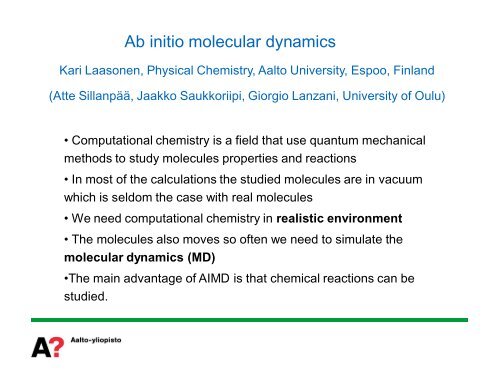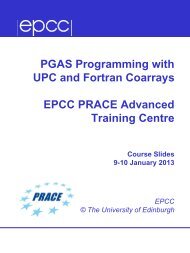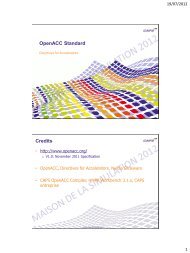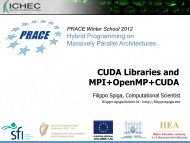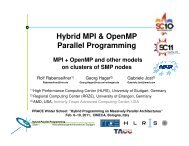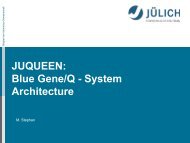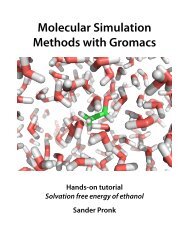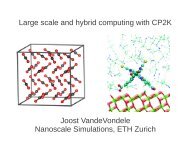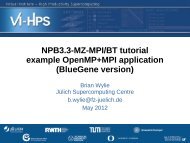Ab initio molecular dynamics - Prace Training Portal
Ab initio molecular dynamics - Prace Training Portal
Ab initio molecular dynamics - Prace Training Portal
- No tags were found...
You also want an ePaper? Increase the reach of your titles
YUMPU automatically turns print PDFs into web optimized ePapers that Google loves.
<strong>Ab</strong> <strong>initio</strong> <strong>molecular</strong> <strong>dynamics</strong>Kari Laasonen, Physical Chemistry, Aalto University, Espoo, Finland(Atte Sillanpää, Jaakko Saukkoriipi, Giorgio Lanzani, University of Oulu)• Computational chemistry is a field that use quantum mechanicalmethods to study molecules properties and reactions• In most of the calculations the studied molecules are in vacuumwhich is seldom the case with real molecules• We need computational chemistry in realistic environment• The molecules also moves so often we need to simulate the<strong>molecular</strong> <strong>dynamics</strong> (MD)•The main advantage of AIMD is that chemical reactions can bestudied.
<strong>Ab</strong> Initio Molecular Dynamics• combining periodic DFT-GGA and MD.• the atoms are treated classically, (Born-Oppenheimer approximation)F = Ma, F = - d V/d R• electrons are included and they are treated using DFT (also HF andhybrid functionals are possible) E KS (,R)• forces are calculated in DFT levelF = - d E KS (,R) / d R• the core electrons are described with effective core potentials• we need to either optimize the electrons at every time step or to use theCar-Parrinello method – expensive calculations• Wavefunctions do not change much between time steps – the previouswf’s are an excellent start for the new ones. => Fast convergence (5-10iterations)
<strong>Ab</strong> Initio Molecular Dynamics• CPMD smooth effective core potentials and plane wave basis set. Car-Parrinello algorithm, time step ca. 0.1 fs• CP2K hard effective core potentials and gaussian basis set. Time stepca. 1 fs. Note: the wavefunctions has to be computed at every time step!• accuracy of GGA is usually good – Van der Waals interactions aremissing. We use DFT + empirical corrections a la Grimme• full arsenal of MD techniques and electronic structure analysis methodsare implemented – thermostats, constraints, thermodynamic integration,Wannier functions, TD-DFT
Computational aspects – CP2K codeDeveloped mostly in Zurich, Prof. Hutter’s grouphttp://cp2k.berlios.de/Free to download (from the address above)Tutorials: 2nd CP2K Tutorial: Enabling the Power of Imagination in MDSimulations. www.cecam.orgVery complex code (800.000+ lines of code, Fortran 95)Huge amount of featuresDifficult to compile and difficult to learn to useImportant help from CSC (compilation)
Computational aspects – CP2K codeEfficient code but in normal application not very good parallel scaling.We are interested of some simulation of 200+ waters and few 100.000 MDsteps. One simulation should not take more month (wall clock time, CrayXX).CP2K scalingA supercomputer is essential100Good scaling up to 1024 cores(10 s/step is makes few 100 pssimulations possible)Time1064water128waterNaCl+475w1024water164 640Cores
<strong>Ab</strong> Initio Molecular Dynamics• examples: Al 2 O n H m Cl 2 + 65 water, Al 5 O n H m Cl k + 144 water, PBE-GGA• various simulations, simulation time scale ca. 100 ps• CPMD or CP2K code, computations with Cray XT5/XT4 (Louhi @CSC)
<strong>Ab</strong> <strong>initio</strong> <strong>molecular</strong> <strong>dynamics</strong> of acidic systemsHydrofluoric Acid• HF acid is a very interesting because at low concentrations it is a weakacid (pH ca. 3) but at high concentration it become very strong acid. HFand water mix with all concentrations.• Sillanpää, A., Simon, C., Klein, M.L., Laasonen, K. J. Phys. Chem. B106, 11315-11322, (2002).• Simon, C., Klein, M.L., ChemPhysChem, 6, 148-153, (2005).Hydrochloric Acid• HCl is a typical strong acid. It’s soluability limit is ca. 30 mol %• We have done DCl:D 2 O simulations with concentrations of 4:28, 7:25 and10:22 at ca. 300 K and 10:22 at 470 K and 910 K.• Sillanpää, A., Laasonen, K. Phys.Chem.Chem.Phys., 6, 555-565, (2004).• Heuft, J.M., Meijer, E.J., Phys.Chem.Chem.Phys., 8, 3116-3123, (2006).
Mixture of Hydrofluoric and Hydrochloric Acid• Simulations:1 HF, 3 HCl, 28 waters,15 ps, NVT, 330 K3 HF, 4 HCl, 25 w, 12 ps + 25 ps NVT, 330 K6 HF, 8 HCl, 18 w, 50 ps, NVT, 350 K, 20 ps, NVE, 320 K6 HF, 8 HCl, 18 w, 40 ps annealing + 60 ps, NVT, 350 K14 HF, 0 HCl, 18 w, 2x50 ps, NVT 350 K(in all simulations dt = 0.121 fs (5 au), = 500 au)• PBE GGA and Vanderbilt pseudopotentials, cut-off 35 Ry• all hydrogens were replaced with deuteriums• we wanted to see how HF is behaving in acid environment• K. Laasonen, J. Larrucea, A. Sillanpää, J. Phys. Chem. B, 120, (2006)
Structure – heavy atoms• O-O distances are much shorter than in water (similar as inconcentrated HF(aq) and HCl(aq))• O coordination is very sensitive to the acid concentration:2.7 (1/3), 2.2 (3/4), 1.1 (6/8), 1.4 (14/0) (const. cut-off 3.0 Å)3.2 (1/3), 2.3 (3/4), 0.9 (6/8), 1.6 (14/0) (integral to the first minimum)• only 1 oxygen around water in the 6/8 simulation ! (in pure water ca. 4)
OH pair correlation functionsGood correlation withhydronium concentration(hydronium is defined byusing OH cutoff of 1.25)The water molecules startloosing their meaning !!O-O coordination ca 1.HHHHProtons are getting very close to heavy atoms.
Free energy profiles for hydrogen.F(q) P(q) RTln max ( P(q))In acids the protons are verymobile, OHO barrier is around 1kJ/mol in the mixture simulation
Some general comments on acid AIMD simulationsYou do not do such simulations with empirical potentialsDoable with AIMDLimitations: time scale, accuracy of GGA
<strong>Ab</strong> <strong>initio</strong> <strong>molecular</strong> <strong>dynamics</strong>aluminum oxide chemistry in aqueous solution• Al oxides are widely used chemicals for water cleaning (coagulation)• Not much are known of their formation chemistry• We have a lot of new mass spectrometer data of these complexes whichneeds computations to resolve the <strong>molecular</strong> structures
<strong>Ab</strong> <strong>initio</strong> <strong>molecular</strong> <strong>dynamics</strong>aluminum oxide chemistry in aqueous solutionloosely bound proton (acidic)normal proton (water)1.48 ÅDistance (Å)Distance (Å)1.35 ÅTime (ps)Time (ps)
<strong>Ab</strong> <strong>initio</strong> <strong>molecular</strong> <strong>dynamics</strong>aluminum oxide chemistry in aqueous solutionfast proton jump correlated to Cl escape attemptO-ClDistance (Å)O-H1.65 Å1.98 Å**1.68 Å3.0 ÅTime (ps)
Constrained MD simulationOne can fix some geometrical parameters and compute the force to this constraint.MetaDynamics allows treatment of more complex reaction.Free energy difference is an integral of this forceTedious calculations since they need long simulation to get good averaging.The constraint can slowly grow or it can be fixed (the later turned out to be moreefficient)Al - ClHHOAl --- ClHHO
Constrained MD simulationTest the hysteresis – grow and reduce the constraint. Theresult should be the same
Constrained MD simulationAlso the static calculations need long simulationsfs
Aluminum oxide chemistry in aqueous solution• reaction barriers• very large ligand effect:Al 1 ClOHw, Al 2 Clw 2• small barriers Cl’s willdissociate14 ± 3 kJ mol -1 40 ± 5 kJ mol -150J. Saukkoriipi and K. Laasonen,J. Phys. Chem. A, 112, 10873 (2008),G (kJ/mol)4030201002,2 2,4 2,6 2,8 3,0 3,2Distance (Å)
Meta<strong>dynamics</strong>Laio, Parrinello, PNAS 99, 12562, 2002Biased <strong>dynamics</strong>Choose few collective variables thatwill describe the problem of interestRun <strong>dynamics</strong>Add small repulsive gaussians to thesystem in places where you have beenAt the end the you will get the freeenergy profile (from the gaussians)A good review: Laio and Gervasio,Rep. Prog. Phys. 71 126601 (2008)
Meta<strong>dynamics</strong>The critical point, the choice of thecollective variableThe Z shape potential:1 CV going from A to B causeeasily too high barrier since CV donot go backwards2 CV better can map this problemDeep problem: real system is veryhigh dimensional, most of them arenot relevant, BUT how many are.And how many CV’s are need.The MetaDynamics (in CP2K)works with 2 CV’s
Example: Al3On reactions (Giorgio Lanzani)CV:s1: d(Al1-Al2)-d(Al1-Al3)2: root mean displacement of the atoms forming the Al-O ring(reference: ring like Al3On)Why such CV’sAlchemy – making different molecules and finding good descriptors of them(experience in Hutter’s group, especially M. Iannuzzi, has been very useful)After long (few 100’s ps) we receive very interesting and complex potentialSurface.To produce this data with distance constrains would have been impossible.
Free energy surface of the considered Al--trimeric cluster at300 K. The geometries corresponding at the local minima (marked inred) and saddle points (blue) are reported as well.
ConclusionsThe AIMD is a very poverfull tool for small systems (less than 1000 atomsand less than 5000 electrons)Time scale is limited to 1 nsThe accuracy is dermined by the DFT-GGA (+vdW)Access to structural, dynamic and electronic propertiesAccess to energy barriers


